Museums
Mariupol Art Museum Named After Arkhip Kuindzhi

The museum was located in the former "Hyacinth estate", built in 1902 in the Art Nouveau style. Its collection numbered about 2,000 exhibits, many of which related to the life and work of the artist Arkhip Kuindzhi. In addition to his works, the museum also included works by Ivan Aivazovskyy, Tetiana Yablonska, Mykola Hlushchenko, Mykhailo Derehus, and others. In the fourth week of the bombing of the city by Russian troops, a russian air bomb hit the museum directly and destroyed it. At the time of the shelling, the original Kuindzhi works were not in the museum. However, the fate of other exhibits is still unknown.
Museum of Antiquities in Chernihiv

The museum building was built in the late nineteenth century in the the popular at that time pseudo-Gothic style. In 1902, a collection of Cossack-Hetman antiquities of the patron Vasyl Tarnovsky was opened there for visitors. The museum survived the shelling of the Bolsheviks in 1918-1919, World War II under Nazi bombs, but it is doubtful whether it will be restored after the "rescue operation" of russia. Fortunately, Tarnowski's collection has recently been preserved in the Chernihiv Historical Museum, and the museum itself functioned as a youth library. There were no people in the building at the time of the shelling.
The Okhtyrka Municipal Local History Museum

The museum was located in a two-story estate of the late nineteenth - early twentieth century. Its collection included about 10,000 items related to local history. In particular, there were artifacts of Cossack Sloboda regiments of Sumy region, personal belongings of the writer Ivan Bagryanyy, amateur theatrical costumes. During the shelling, the windows of the museum were broken, the walls were damaged and the roof was destroyed. The fate of the museum fund is still unknown.
Ivankiv Historical and Local History Museum

This building was not an architectural monument, but it has a long history. Built in the XIX century and significantly rebuilt in Soviet times, it contained a collection of works by artist Maria Pryimachenko and embroiderer Anna Veres, as well as local artifacts from different times (mammoth bones, Bronze Age coins, Chernyakhiv culture utensils, Cossack weapons, ancient icons). Due to the fighting of Russian troops, the museum building completely burned down. There is no exact information about the museum fund, but there is information that some of Pryimachenko's works were on display at the Odessa Art Museum, and local residents saved the other part.
Historical and Architectural Museum-Reserve "Popov Manor House"
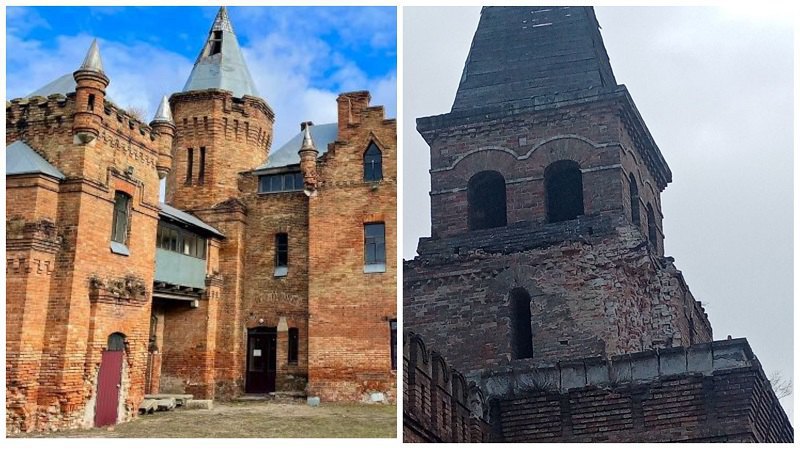
The estate in Vasylivka was built in 1894. To this day, jagged walls with a gate, several outbuildings, a brick observation tower and a stable have preserved from the original building. The Popov family lived on the estate before the October Revolution. The estate had an observatory and meteorological station enrolled in the meteorological services of the Russian Empire. After 1917, the Bolsheviks looted the estate, destroyed the ethnographic collection, stole some of the sculptures and furniture, and in particular - a marble toilet bowl. He was later returned to the castle, along with some other items. In Soviet times, there was a pigsty here, then a dormitory, and in the 1990s the building was turned into a museum. In 2022, after shelling that damaged the walls of the building, russian troops looted the museum - took out everything they could, including the same marble toilet bowl from the time of Count Popov.
Temples
Holy Dormition Svyatogorsk Lavra
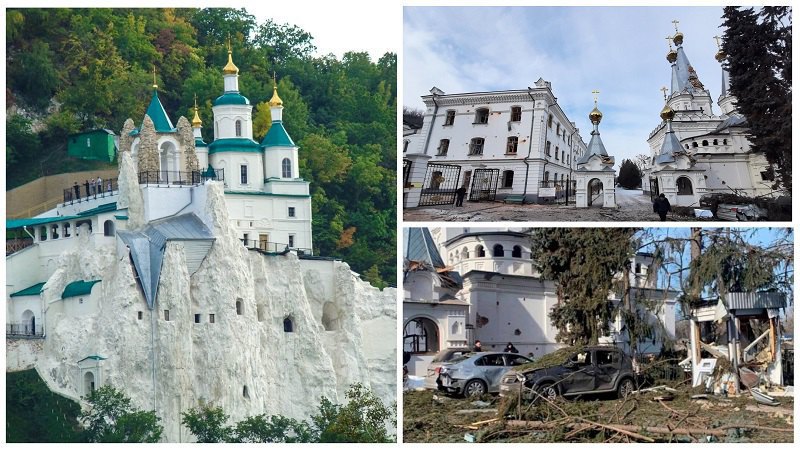
The monastery has a long and complex history. In this area in the VIII-IX centuries icon-defenders hid from iconoclasts, and in the XII-XIII centuries, the locals escaped from the horde. In the XVI-XVII centuries, the monastery was a Christian outpost, but after the conquest of Crimea by the Russian Empire, it lost its military significance and was secularized. The territory went to Catherine II's favorite, Prince Potemkin, and the monastery itself was looted by Russian officials. In the middle of the XIX century, the monastery was reopened, but not for long - the Bolsheviks looted its hermitages, the buildings were turned into a rest house, and the main cathedral was turned into a cinema. The monastery, revived for the second time in the 1990s, was severely damaged by airstrikes by Russian troops: its facades and windows, roofs, and sculptures were destroyed.
Yelets Assumption Monastery in Chernihiv
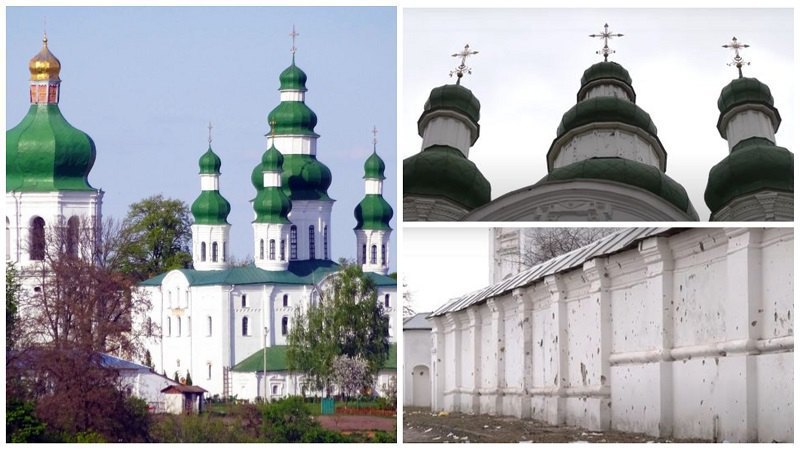
This monastery is one of the oldest in Ukraine. It was founded in 1060 by Prince Svyatoslav Yaroslavych, destroyed during the Mongol invasion, restored during the reign of the Rzeczpospolita, later rebuilt in the Cossack Baroque style. In the 1920s, it was closed and looted by the Soviet authorities. They broke Silver and gilded utensils, church utensils of the XVII-XIX centuries, turned them into scrap, and took them out in boxes. During the last invasion of the russian federation, the shelling damaged the facades of the monastery walls and gates with a bell tower of the XVII century, the drums of the domes of the Assumption Cathedral of the XII-XVII centuries.
Holy Dormition Cathedral in Kharkiv

The cathedral building was erected at the end of the XVIII century, and its Alexander Bell Tower at the beginning of the XIX century, in honor of the victory in the war with Napoleon. Almost 90 meters high, at that time it was one of the tallest buildings in the Russian Empire. In the 1920s, the Soviet government removed all valuables from the cathedral. The wooden iconostasis, gathered according to Rastrelli's drawings, was taken to the Kharkiv Art Museum. The antenna of the first radio station of the Ukrainian SSR was installed on the bell tower; later, it was moved inside the cathedral, damaging its frescoes. During the Second World War, the cathedral miraculously survived, although many buildings around it were destroyed, but the iconostasis in the museum warehouse burned down. Eighty years later, shelling by Russian troops damaged the cathedral, smashed windows, and destroyed stained glass.
Church of the Nativity of the Blessed Virgin in Vyazivka

Built in 1862, the Orthodox church in the village of Vyazivka, Zhytomyr region, was considered an architectural monument of national importance. The church was wooden, built on a stone foundation. During the russian invasion of Ukraine, the occupiers completely destroyed the unique temple. Only the bell tower, which also suffered severe damage, survived.
St. George's Church in Zavorychi

A single-domed wooden church in the village of Zavorychi, Kyiv region, was built in 1873. In 1935, the Soviet authorities closed it down and turned it into a granary. However, until recently, the ceiling and naves of the building kept the original paintings depicting the Virgin and the salvation of Peter. As a result of shelling by Russian troops, the church burned down. Eyewitnesses say that the occupiers deliberately sent one of the shells to the temple's dome.
Theaters and concert halls
Donetsk Regional Drama Theater in Mariupol

The Mariupol Theater has become a symbol of the humanitarian catastrophe caused by russia. Its troops deliberately bombed the building, which became a refuge for thousands of people in the ruined city. The theater building, erected in the late 1950s, is a monument to Soviet monumental classicism. Fortunately, people hiding in its basement survived, but the building did not survive the Russian invasion. The Italian government promised to restore it after the war.
Cinema named after Shchorsa in Chernihiv

The building of the Chernihiv Youth Center, and until 2017 - the Shchors Cinema, was an architectural monument of local significance. The cinema was built in 1939, it became the best-equipped cinema hall in the city. German troops destroyed the building during World War II. It was rebuilt in 1947. The open trial of German and Hungarian prisoners of war who committed war crimes took place there. Now the cinema building was destroyed by russian troops with a missile strike. In the future, their open trial should be held there.
Dnieper House of Organ and Chamber Music

The organ hall functioned in the building of the Bryansk Church, founded in 1913 in honor of the 300th anniversary of the Romanov family. Built in the style of neoclassicism with Baroque elements, the building was considered one of the most beautiful in Ekaterinoslav [name of Dnieper in those times], and later it acquired the status of an architectural monument of national importance. Since the 1930s, the church was used as a house of pioneers, a sports school, and a coal warehouse. In 1980, it was reconstructed and an organ commissioned by the German company Sauer in Frankfurt an der Oder was installed. The building of the organ hall was damaged by shelling by Russian troops. Shell fragments hit its walls and windows. There is no information about the state of the organ yet.
Historic buildings
Sumy cadet corps
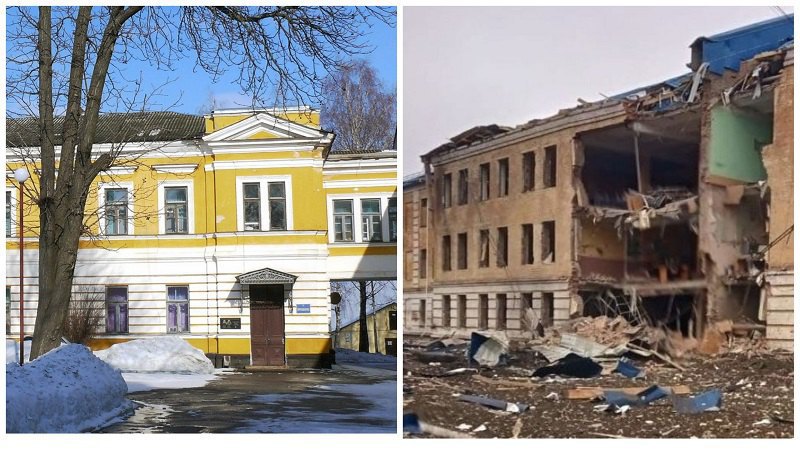
The architectural complex of the cadet corps was built in 1903 according to the project of the Kyiv architect Karol Ivanytsky. Its buildings combine three versions of historicism - neoclassicism, neo-Gothic, "brick style". Tens of thousands of Ukrainian officers studied here, many of whom are now at war with the russian occupiers. A rocket attack by russian troops caused considerable damage to this architectural monument.
Sumy Theological Seminary
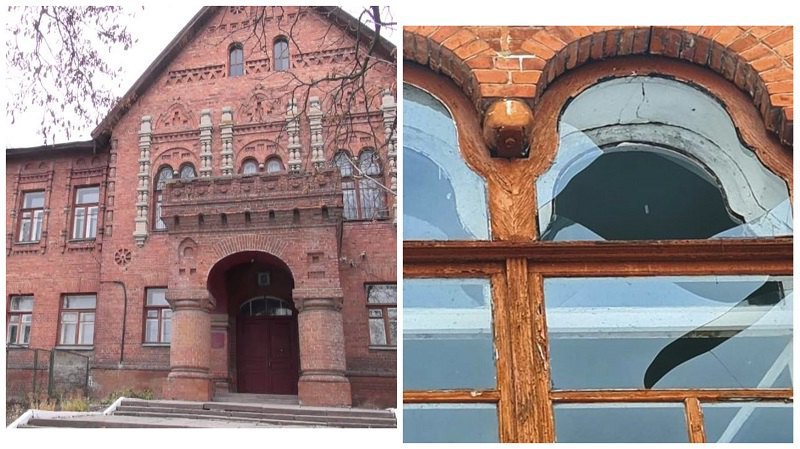
The bishop's corps in Sumy, which later housed the seminary, was built in the 1910s in a pseudo-russian style. In Soviet times, a military commissariat was located here. During the Russian invasion, airstrikes significantly damaged the facades and windows of this old building.
Korolenko Library in Kharkiv
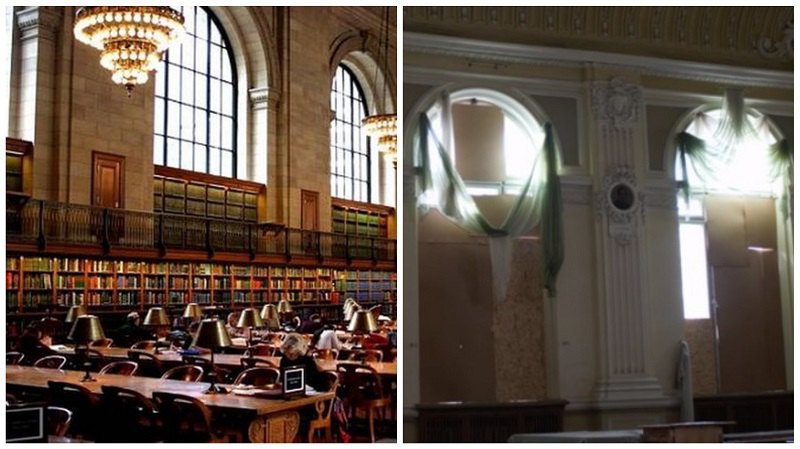
Erected in the early twentieth century, designed by architect Alexei Beketov, this scientific library has gathered a unique collection of documents. In 1903, it became the first public book collection of the Russian Empire, which, following the example of Parisian libraries, opened a music department. Later, influential departments of manuscripts, autographs, and Jewish studies were formed there. In Ukraine, it was the second-largest film fund after the Vernadsky Library. The shelling of russian troops damaged the facade of the architectural monument, knocked out windows, damaged two bookstores, the main building and the grand piano. Once russian composer Sergei Rachmaninoff played this piano.
House №8 on Svobody Street in Kharkiv
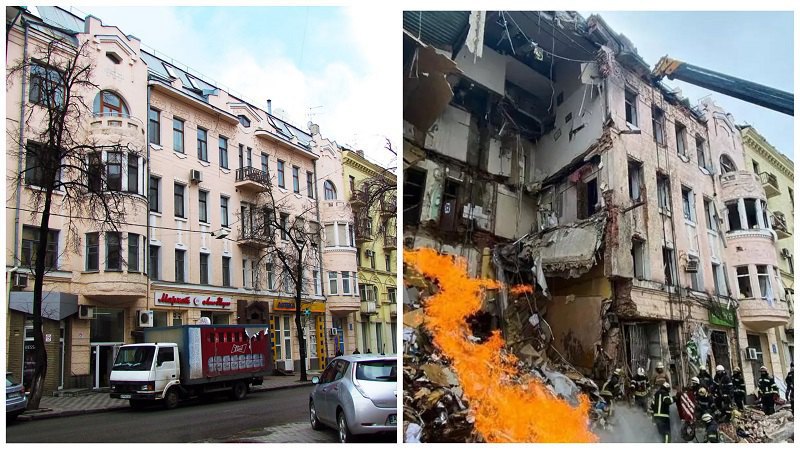
Built in 1911 as a profitable house for the merchant Maslowski, the house was a brilliant example of Kharkiv Art Nouveau and an architectural monument of local significance. Its architect, Moses Meletynskyy, moved to Moscow in the 1920s, where he built the Moscow Metro. Russian soldiers, who were probably traveling on the subway, completely destroyed the house with a targeted missile strike. At least two people were killed.
House №3 on Constitution Square in Kharkiv
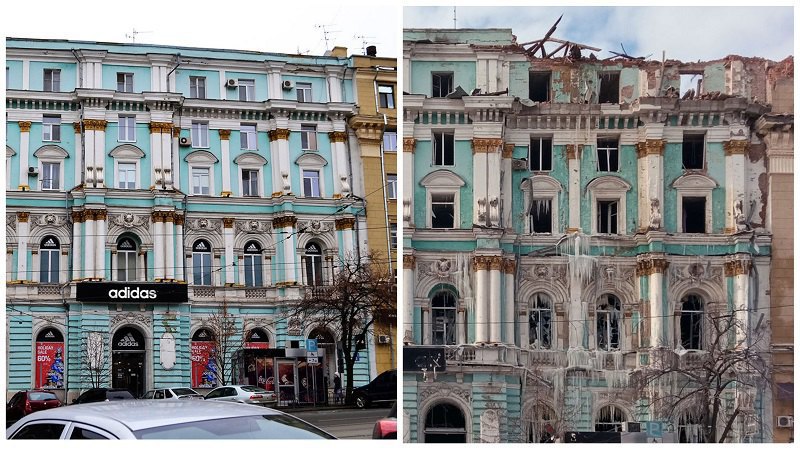
Another architectural monument in Kharkiv is a house designed in 1894 as a lodging house with a shop for the "Ponomarev and Ryzhov" Society. According to one version, the project's author was a famous Scottish architect Alexander "Greek" Thomson. In 1954, additional floors were added to the building. In the 1980s there was a department store "Lux" (goods for women). During the bombing of the center of Kharkiv, Russian troops destroyed the house.
Slovo House in Kharkiv
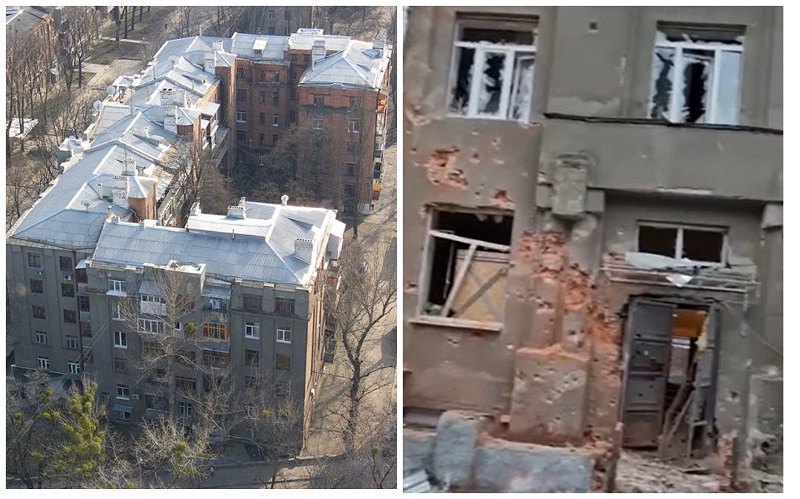
The legendary C-shaped house "Slovo" was built in the late 1920s by architect Mykhailo Dashkevych in forms that combined modernism with constructivism. It housed a cooperative of writers, where representatives of the "Executed Renaissance" lived and worked. By 1938, Soviet authorities had repressed residents of forty out of sixty-six apartments. Recently, a literary residence had been operating in the "Slovo" building. During the russian invasion, its residents had to leave the city immediately. The house, which is a cultural heritage site of Ukraine, was damaged by the shells of the russian army.
Okhtyrka railway station

The Okhtyrka railway station was opened in 1895. It was located on the mainline Kharkiv - Sumy. Construction of the railway in Okhtyrka began in 1893, and in 1895 the first freight train passed here. During the russian invasion, the occupying forces completely destroyed the old building of the Okhtyrka railway station.
Outside of architecture
Architectural losses are the most obvious. They are difficult not to notice, easy to record, convenient to use as an argument in discussions. But they are not alone. And not even the most painful. We will never be able to regain our pre-war cities - we still have to realize this fact. But, albeit in a different way, we will be able to rebuild the city and reopen theaters, cinemas, museums, and concert halls. However, we cannot bring back the people who died in this war. And unable to recoup the time spent on it.
Our cultural losses are the artist of the National Opera, who will never dance again, the actress of the "Molodyy" Theater, who will no longer play in it, the founder of the publishing house "Oriyentyr", which will not publish new books. These are uncreated works by artists who weave camouflage nets and make anti-tank hedgehogs, unpublished films by directors, and unwritten novels by writers who went to the defense. These are unorganized residences that accept refugees, unrealized grants spent on the army, unseen performances, unheard concerts, unread books. This is the uneducated education of our children, who will have to rebuild our culture. Cultural losses are within us, and any reparations cannot compensate them.








